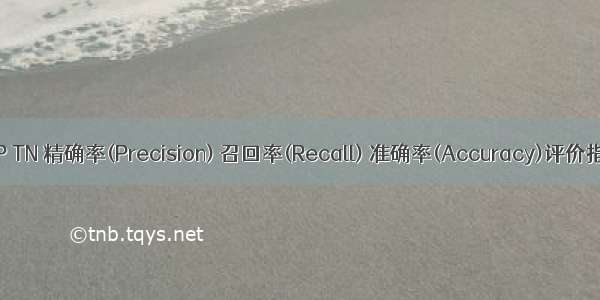
目录
一、FP、FN、TP、TN
二、准确率(Accuracy)、精确率(Precision)、召回率(Recall)、F1score
2.1、准确率(Accuracy)
2.2、召回率(Recall)
2.3、精确率(Precision)
2.4、敏感度、特异度、假阳性率、阳性预测值、阴性预测值
2.5、F1score
三、绘制ROC曲线,及计算以上评价参数
3.1、什么是ROC
3.2、绘制二分类ROC
四、更普遍的方法,绘制ROC
五、多分类的ROC曲线
六、FROC拓展
七、MedCalc统计软件绘制ROC
八、AUC值
在对模型性能进行评估的时候,经常会遇到各种各样的新名词,这里面就包括了混淆矩阵、ROC、AUC等等的名词。本文就对常用的评价参数进行了罗列和实现绘制,方便使用。
一、FP、FN、TP、TN
你这蠢货,是不是又把酸葡萄和葡萄酸弄“混淆“”啦!!!这里的混淆,我们细品。
上面日常情况中的混淆就是:是否把某两件东西或者多件东西给弄混了,迷糊了。
在机器学习中,混淆矩阵是一个误差矩阵, 常用来可视化地评估监督学习算法的性能.。混淆矩阵大小为 (n_classes, n_classes) 的方阵, 其中 n_classes 表示类的数量。
其中,这个矩阵的一行表示预测类中的实例(可以理解为模型预测输出,predict, PD),另一列表示对该预测结果对应的标签(Ground Truth, GT)进行判定模型的预测结果是否正确,正确为True,反之为False。
在机器学习中ground truth表示有监督学习的训练集的分类准确性,用于证明或者推翻某个假设。有监督的机器学习会对训练数据打标记,试想一下如果训练标记错误,那么将会对测试数据的预测产生影响,因此这里将那些正确打标记的数据成为ground truth。
此时,就引入FP、FN、TP、TN与精确率(Precision),召回率(Recall),准确率(Accuracy)等等评价方式,我们在后面详述。
以猫狗二分类为例,假定
cat为正例1-Positive1,dog为正例2-Positive2,其他为负例-Negative;预测正确为True,反之,预测错误为False。我们针对cat或dog,就可以得到下面这样一个表示FP、FN、TP、TN的表:
在计算混淆矩阵的时候,我们可以使用scikit-learn 科学计算包,计算混淆矩阵函数 sklearn.metrics.confusion_matrix API 接口,可以快速帮助我们绘制混淆矩阵。接口定义如下:
skearn.metrics.confusion_matrix(y_true, # array, Gound true (correct) target valuesy_pred, # array, Estimated targets as returned by a classifierlabels=None, # array, List of labels to index the matrix.sample_weight=None # array-like of shape = [n_samples], Optional sample weights)
完整示例代码如下:
__author__ = "lingjun"# E-mail: 1763469890@import seaborn as snsfrom sklearn.metrics import confusion_matriximport matplotlib.pyplot as pltsns.set()f, (ax1,ax2) = plt.subplots(figsize = (10, 8),nrows=2)y_true = ["dog", "dog", "dog", "cat", "cat", "cat", "cat"]y_pred = ["cat", "cat", "dog", "cat", "cat", "cat", "cat"]C2= confusion_matrix(y_true, y_pred, labels=["dog", "cat"])print(C2)print(C2.ravel())sns.heatmap(C2,annot=True)ax2.set_title('sns_heatmap_confusion_matrix')ax2.set_xlabel('Pred')ax2.set_ylabel('True')f.savefig('sns_heatmap_confusion_matrix.jpg', bbox_inches='tight')
保存的图像如下所示:
这个时候我们还是不知道skearn.metrics.confusion_matrix做了些什么,这个时候print(C2),打印看下C2究竟里面包含着什么。最终的打印结果如下所示:
[[1 2][0 4]][1 2 0 4]
解释下上面这几个数字的意思:
C2= confusion_matrix(y_true, y_pred, labels=["dog", "cat"])中的labels的顺序就分布是0、1,negative和positive注:labels=[]可加可不加,不加情况下会自动识别,自己定义
在计算cat的混淆矩阵的时候,cat就是阳性,dog和其他,就是阴性,如下面这样:
cat为1-positive,其中真实值中cat有4个,4个被预测为cat,预测正确T,0个被预测为dog,预测错误F;dog为0-negative,其中真实值中dog有3个,1个被预测为dog,预测正确T,2个被预测为cat,预测错误F。
定义:
TP:正确的预测为正例,也就是预测为正例,预测对了TN:正确的预测为反例,也就是预测为反例,预测对了FP:错误的预测为正例,也就是预测为正例,预测错了FN:预测的预测为反例,也就是预测为反例,预测错了
所以:在分别以狗dog和猫cat为正例,预测错位为反例中,会分别得到如下两个混淆矩阵:
dog-1,其他为0:y_true = ["1", "1", "1", "0", "0", "0", "0"]y_pred = ["0", "0", "1", "0", "0", "0", "0"]TP:1TN:4FP:0FN:2cat-1,其他为0:y_true = ["0", "0", "0", "1", "1", "1", "1"]y_pred = ["1", "1", "0", "1", "1", "1", "1"]TP:4TN:1FP:2FN:0
注意:混淆矩阵是评价某一模型预测结果好坏的方法,预测对与错的参照标准是标注结果。其中,需要对预测置信度进行阈值分割。
大于该阈值的,为预测阳性小于该阈值的,为预测阴性
所以,确定该类的阈值是多少,很重要,直接决定了混淆矩阵的数值分布。其中,该阈值可根据ROC曲线进行确定,这块下文会详述,继续往后看。
从这里就可以看出,混淆矩阵的衡量是很片面的,依据混淆矩阵计算的精确率、召回率、准确率等等评价方法,也是很片面的。这就是他们的缺点,需要一个更加全面的评价指标的出现。
二、准确率(Accuracy)、精确率(Precision)、召回率(Recall)、F1score
有了上面的这些混淆矩阵的数值,就可以进行如下准确率、精确率、召回率、F1score等等评价指标的的计算工作了
2.1、准确率(Accuracy)
这三个指标里最直观的就是准确率: 模型判断正确的数据(TP+TN)占总数据的比例
"Accuracy: "+str(round((tp+tn)/(tp+fp+fn+tn), 3))
2.2、召回率(Recall)
针对数据集中的所有正例label(TP+FN)而言,模型正确判断出的正例(TP)占数据集中所有正例的比例;FN表示被模型误认为是负例但实际是正例的数据;
召回率也叫查全率,以物体检测为例,我们往往把图片中的物体作为正例,此时召回率高代表着模型可以找出图片中更多的物体!
"Recall: "+str(round((tp)/(tp+fn), 3))
2.3、精确率(Precision)
针对模型判断出的所有正例(TP+FP)而言,其中真正例(TP)占的比例。精确率也叫查准率,还是以物体检测为例,精确率高表示模型检测出的物体中大部分确实是物体,只有少量不是物体的对象被当成物体。
"Precision: "+str(round((tp)/(tp+fp), 3))
2.4、敏感度、特异度、假阳性率、阳性预测值、阴性预测值
还有,敏感度Sensitivity、特异度Specificity、假阳性率False positive rate、阳性预测值Positive predictive value、阴性预测值Negative predictive value,分别的计算方法如下所示:
("Sensitivity: "+str(round(tp/(tp+fn+0.01), 3)))("Specificity: "+str(round(1-(fp/(fp+tn+0.01)), 3)))("False positive rate: "+str(round(fp/(fp+tn+0.01), 3)))("Positive predictive value: "+str(round(tp/(tp+fp+0.01), 3)))("Negative predictive value: "+str(round(tn/(fn+tn+0.01), 3)))
其中:
敏感度=召回率,都是看label标记是阳性中,预测pd有多少真是阳性特异度是看label标记是阴性中,预测pd有多少是真的阴性,这里的阴性可以是一大类。假设需要评估的类是马路上的人,那除人之外,其他类别均可以作为人相对应的阴性在医学领域,敏感度更关注漏诊率(有病之人不能漏),特异度更关注误诊率(无病之人不能误)假阳性率 = 1 - 特异度,假阳性越多,误诊越多阳性预测值 = 精确率,是看预测为阳性中,有多少是真阳性阴性预测值是看预测为阴性中,有多少是真阴性
2.5、F1score
要计算F1score,需要先计算精确率和召回率。其中:
Precision = tp/tp+fpRecall = tp/tp+fn进而计算得到:F1score = 2 *Precision *Recall /(Precision +Recall)
那么,你有没有想过,F1score中,recall和Precision对其的影响是怎么样的。我们用如下代码,绘制出来看看。
import numpy as npimport matplotlib.pyplot as pltfig = plt.figure() #定义新的三维坐标轴ax3 = plt.axes(projection='3d')#定义三维数据precision = np.arange(0.01, 1, 0.1)recall = np.arange(0.01, 1, 0.1)X, Y = np.meshgrid(precision, recall) # 用两个坐标轴上的点在平面上画网格Z = 2*X*Y/(X+Y)# 作图ax3.plot_surface(X, Y, Z, rstride = 1, cstride = 1, cmap='rainbow')plt.xlabel('precision')plt.ylabel('recall')plt.title('F1 score')plt.show()
数据分布图如下:
可以看出,精准度和recall,无论任何一个低,F1score都不会高,只有两个都高的时候,分数才会高,这也能够说明,为啥很多评价都是采用F1 score。
三、绘制ROC曲线,及计算以上评价参数
3.1、什么是ROC
在上文混淆矩阵时候,我们提到:混淆矩阵的绘制严重依赖一个固定的阈值,在确定该阈值的前提下,才能确定混淆矩阵的数值,这种对模型评价方式是面片,不全面的。
此时,迫切需要一中评价方式,能够更加全面的对模型进行评估,于是就出现的ROC曲线,如下所示:
其中:
横轴:False Positive Rate(假阳率,FPR)纵轴:True Positive Rate(真阳率,TPR)
连接(0,0)和(1,1)绿色曲线上的任意一点,是在该阈值下,对应的混淆矩阵下的假阳性率和真阳性率。例如图中的(0.1,0.8),即该阈值 t 下,假阳性率为0.1,真阳性率为0.8。
3.2、绘制二分类ROC
如下为统计数据:
下面的代码,就是要读取上面的CSV文档,对该类别绘制ROC曲线。这里只是一个范例,你根据自己的数据情况进行针对性的修改即可。其中+表示阳性,-表示阴性
__author__ = "lingjun"# E-mail: 1763469890@from sklearn.metrics import roc_auc_score, confusion_matrix, roc_curve, aucfrom matplotlib import pyplot as pltimport numpy as npimport torchimport csvdef confusion_matrix_roc(GT, PD, experiment, n_class):GT = GT.numpy()PD = PD.numpy()y_gt = np.argmax(GT, 1)y_gt = np.reshape(y_gt, [-1])y_pd = np.argmax(PD, 1)y_pd = np.reshape(y_pd, [-1])# ---- Confusion Matrix and Other Statistic Information ----if n_class > 2:c_matrix = confusion_matrix(y_gt, y_pd)# print("Confussion Matrix:\n", c_matrix)list_cfs_mtrx = c_matrix.tolist()# print("List", type(list_cfs_mtrx[0]))path_confusion = r"./records/" + experiment + "/confusion_matrix.txt"# np.savetxt(path_confusion, (c_matrix))np.savetxt(path_confusion, np.reshape(list_cfs_mtrx, -1), delimiter=',', fmt='%5s')if n_class == 2:list_cfs_mtrx = []tn, fp, fn, tp = confusion_matrix(y_gt, y_pd).ravel()list_cfs_mtrx.append("TN: " + str(tn))list_cfs_mtrx.append("FP: " + str(fp))list_cfs_mtrx.append("FN: " + str(fn))list_cfs_mtrx.append("TP: " + str(tp))list_cfs_mtrx.append(" ")list_cfs_mtrx.append("Accuracy: " + str(round((tp + tn) / (tp + fp + fn + tn), 3)))list_cfs_mtrx.append("Sensitivity: " + str(round(tp / (tp + fn + 0.01), 3)))list_cfs_mtrx.append("Specificity: " + str(round(1 - (fp / (fp + tn + 0.01)), 3)))list_cfs_mtrx.append("False positive rate: " + str(round(fp / (fp + tn + 0.01), 3)))list_cfs_mtrx.append("Positive predictive value: " + str(round(tp / (tp + fp + 0.01), 3)))list_cfs_mtrx.append("Negative predictive value: " + str(round(tn / (fn + tn + 0.01), 3)))path_confusion = r"./records/" + experiment + "/confusion_matrix.txt"np.savetxt(path_confusion, np.reshape(list_cfs_mtrx, -1), delimiter=',', fmt='%5s')# ---- ROC ----plt.figure(1)plt.figure(figsize=(6, 6))fpr, tpr, thresholds = roc_curve(GT[:, 1], PD[:, 1])roc_auc = auc(fpr, tpr)plt.plot(fpr, tpr, lw=1, label="positive vs negative, area=%0.3f)" % (roc_auc))# plt.plot(thresholds, tpr, lw=1, label='Thr%d area=%0.2f)' % (1, roc_auc))# plt.plot([0, 1], [0, 1], '--', color=(0.6, 0.6, 0.6), label='Luck')plt.xlim([0.00, 1.0])plt.ylim([0.00, 1.0])plt.xlabel("False Positive Rate")plt.ylabel("True Positive Rate")plt.title("ROC")plt.legend(loc="lower right")plt.savefig(r"./records/" + experiment + "/ROC.png")print("ok")def inference():GT = torch.FloatTensor()PD = torch.FloatTensor()file = r"Sensitive_rename_inform.csv"with open(file, 'r', encoding='UTF-8') as f:reader = csv.DictReader(f)for row in reader:# TODOmax_patient_score = float(row['ai1'])doctor_gt = row['gt2']print(max_patient_score,doctor_gt)pd = [[max_patient_score, 1-max_patient_score]]output_pd = torch.FloatTensor(pd).to(device)if doctor_gt == "+":target = [[1.0, 0.0]]else:target = [[0.0, 1.0]]target = torch.FloatTensor(target) # 类型转换, 将list转化为tensor, torch.FloatTensor([1,2])Target = torch.autograd.Variable(target).long().to(device)GT = torch.cat((GT, Target.float().cpu()), 0) # 在行上进行堆叠PD = torch.cat((PD, output_pd.float().cpu()), 0)confusion_matrix_roc(GT, PD, "ROC", 2)if __name__ == "__main__":inference()
若是表格里面有中文,则记得这里进行修改,否则报错
with open(file, 'r') as f:
四、更普遍的方法,绘制ROC
这是两个文件夹,存储的都是记录图像预测结果的txt文件,分别是:
tb表示的是positive样本预测的txt文件集,一个图像对应一个txtnontb表示的是negative样本预测的txt文件集,一个图像对应一个txt每一个txt文件记录的都是该图像预测的置信率(我这里是目标检测、分割问题,所以一个图像里面,可能会存在两个目标的问题)
如下是实现的代码,整体内容与上一个绘制ROC的方法差不多,只是读取数据的方式不同。
import csvimport numpy as npimport torchimport osfrom matplotlib import pyplot as pltfrom sklearn.metrics import roc_auc_score, confusion_matrix, roc_curve, aucdef confusion_matrix_roc(GT, PD, experiment, n_class):GT = GT.numpy()PD = PD.numpy()y_gt = np.argmax(GT, 1)y_gt = np.reshape(y_gt, [-1])y_pd = np.argmax(PD, 1)y_pd = np.reshape(y_pd, [-1])# ---- Confusion Matrix and Other Statistic Information ----if n_class > 2:c_matrix = confusion_matrix(y_gt, y_pd)# print("Confussion Matrix:\n", c_matrix)list_cfs_mtrx = c_matrix.tolist()# print("List", type(list_cfs_mtrx[0]))path_confusion = r"./records/" + experiment + "/confusion_matrix.txt"# np.savetxt(path_confusion, (c_matrix))np.savetxt(path_confusion, np.reshape(list_cfs_mtrx, -1), delimiter=',', fmt='%5s')if n_class == 2:list_cfs_mtrx = []tn, fp, fn, tp = confusion_matrix(y_gt, y_pd).ravel()list_cfs_mtrx.append("TN: " + str(tn))list_cfs_mtrx.append("FP: " + str(fp))list_cfs_mtrx.append("FN: " + str(fn))list_cfs_mtrx.append("TP: " + str(tp))list_cfs_mtrx.append(" ")list_cfs_mtrx.append("Accuracy: " + str(round((tp + tn) / (tp + fp + fn + tn), 3)))list_cfs_mtrx.append("Sensitivity: " + str(round(tp / (tp + fn + 0.01), 3)))list_cfs_mtrx.append("Specificity: " + str(round(1 - (fp / (fp + tn + 0.01)), 3)))list_cfs_mtrx.append("False positive rate: " + str(round(fp / (fp + tn + 0.01), 3)))list_cfs_mtrx.append("Positive predictive value: " + str(round(tp / (tp + fp + 0.01), 3)))list_cfs_mtrx.append("Negative predictive value: " + str(round(tn / (fn + tn + 0.01), 3)))path_confusion = r"./records/confusion_matrix.txt"np.savetxt(path_confusion, np.reshape(list_cfs_mtrx, -1), delimiter=',', fmt='%5s')# ---- ROC ----plt.figure(1)plt.figure(figsize=(6, 6))fpr, tpr, thresholds = roc_curve(GT[:, 1], PD[:, 1])roc_auc = auc(fpr, tpr)return fpr, tpr, roc_auc# plt.plot(fpr, tpr, lw=1, label="ATB vs NotTB, area=%0.3f)" % (roc_auc))# # plt.plot(thresholds, tpr, lw=1, label='Thr%d area=%0.2f)' % (1, roc_auc))# # plt.plot([0, 1], [0, 1], '--', color=(0.6, 0.6, 0.6), label='Luck')## plt.xlim([0.00, 1.0])# plt.ylim([0.00, 1.0])# plt.xlabel("False Positive Rate")# plt.ylabel("True Positive Rate")# plt.title("ROC")# plt.legend(loc="lower right")# plt.savefig(r"./records/" + experiment + "/ROC.png")def draw_ROC(file):GT = torch.FloatTensor()PD = torch.FloatTensor()pred_tb_num = 0for (path, dirs, files) in os.walk(file):for filename in files:txt_path = os.path.join(path, filename)label_flag = txt_path.split("\\")[-2]size = os.path.getsize(txt_path)if size != 0:print('文件不是空的')list_socre = []with open(txt_path, "r") as f:for line in f.readlines():line = line.strip('\n') # 去掉列表中每一个元素的换行符list_socre.append(line)max_score=max(list_socre)print("max_score:",max_score)output = [[1-float(max_score), float(max_score)]]print("output=", output)output = torch.FloatTensor(output) # 类型转换, 将list转化为tensor, torch.FloatTensor([1,2])# output_pd = torch.autograd.Variable(output).long().to('cpu')PD = torch.cat((PD, output.float().cpu()), 0) # 在行上进行堆叠print(label_flag)if label_flag == "tb":target = [[0.0, 1.0]]else:target = [[1.0, 0.0]]print("target=", target)target = torch.FloatTensor(target) # 类型转换, 将list转化为tensor, torch.FloatTensor([1,2])GT = torch.cat((GT, target.float().cpu()), 0) # 在行上进行堆叠else:output = [[1.0, 0.0]]print("output=", output)output = torch.FloatTensor(output) # 类型转换, 将list转化为tensor, torch.FloatTensor([1,2])# output_pd = torch.autograd.Variable(output).long().to('cpu')PD = torch.cat((PD, output.float().cpu()), 0) # 在行上进行堆叠print(label_flag)if label_flag == "tb":target = [[0.0, 1.0]]else:target = [[1.0, 0.0]]print("target=", target)target = torch.FloatTensor(target) # 类型转换, 将list转化为tensor, torch.FloatTensor([1,2])GT = torch.cat((GT, target.float().cpu()), 0) # 在行上进行堆叠print(len(GT))return GT, PDif __name__=='__main__':file = r"Z:\reslt_pd"GT_no, PD_no = draw_ROC(file)fpr_no, tpr_no, roc_auc_no = confusion_matrix_roc(GT_no, PD_no, "ROC", 2)plt.plot(fpr_no, tpr_no, lw=1, label="positive vs negative, area=%0.3f)" % (roc_auc_no))#plt.plot(fpr, tpr, lw=1, label="ATB vs NotTB ReduceFP, area=%0.3f)" % (roc_auc))# plt.plot(thresholds, tpr, lw=1, label='Thr%d area=%0.2f)' % (1, roc_auc))# plt.plot([0, 1], [0, 1], '--', color=(0.6, 0.6, 0.6), label='Luck')plt.xlim([0.00, 1.0])plt.ylim([0.00, 1.0])plt.xlabel("1-specificity")plt.ylabel("sensitivity")plt.title("ROC")plt.legend(loc="lower right")plt.savefig(r"ROC.png")
五、多分类的ROC曲线
参考链接:ROC原理介绍及利用python实现二分类和多分类的ROC曲线_闰土不用叉的博客-CSDN博客_roc曲线python
# 引入必要的库import numpy as npimport matplotlib.pyplot as pltfrom itertools import cyclefrom sklearn import svm, datasetsfrom sklearn.metrics import roc_curve, aucfrom sklearn.model_selection import train_test_splitfrom sklearn.preprocessing import label_binarizefrom sklearn.multiclass import OneVsRestClassifierfrom scipy import interp# 加载数据iris = datasets.load_iris()X = iris.datay = iris.target# 将标签二值化y = label_binarize(y, classes=[0, 1, 2])# 设置种类n_classes = y.shape[1]# 训练模型并预测random_state = np.random.RandomState(0)n_samples, n_features = X.shape# shuffle and split training and test setsX_train, X_test, y_train, y_test = train_test_split(X, y, test_size=.5,random_state=0)# Learn to predict each class against the otherclassifier = OneVsRestClassifier(svm.SVC(kernel='linear', probability=True,random_state=random_state))y_score = classifier.fit(X_train, y_train).decision_function(X_test)# 计算每一类的ROCfpr = dict()tpr = dict()roc_auc = dict()for i in range(n_classes):fpr[i], tpr[i], _ = roc_curve(y_test[:, i], y_score[:, i])roc_auc[i] = auc(fpr[i], tpr[i])# Compute micro-average ROC curve and ROC area(方法二)fpr["micro"], tpr["micro"], _ = roc_curve(y_test.ravel(), y_score.ravel())roc_auc["micro"] = auc(fpr["micro"], tpr["micro"])# Compute macro-average ROC curve and ROC area(方法一)# First aggregate all false positive ratesall_fpr = np.unique(np.concatenate([fpr[i] for i in range(n_classes)]))# Then interpolate all ROC curves at this pointsmean_tpr = np.zeros_like(all_fpr)for i in range(n_classes):mean_tpr += interp(all_fpr, fpr[i], tpr[i])# Finally average it and compute AUCmean_tpr /= n_classesfpr["macro"] = all_fprtpr["macro"] = mean_tprroc_auc["macro"] = auc(fpr["macro"], tpr["macro"])# Plot all ROC curveslw=2plt.figure()plt.plot(fpr["micro"], tpr["micro"],label='micro-average ROC curve (area = {0:0.2f})'''.format(roc_auc["micro"]),color='deeppink', linestyle=':', linewidth=4)plt.plot(fpr["macro"], tpr["macro"],label='macro-average ROC curve (area = {0:0.2f})'''.format(roc_auc["macro"]),color='navy', linestyle=':', linewidth=4)colors = cycle(['aqua', 'darkorange', 'cornflowerblue'])for i, color in zip(range(n_classes), colors):plt.plot(fpr[i], tpr[i], color=color, lw=lw,label='ROC curve of class {0} (area = {1:0.2f})'''.format(i, roc_auc[i]))plt.plot([0, 1], [0, 1], 'k--', lw=lw)plt.xlim([0.0, 1.0])plt.ylim([0.0, 1.05])plt.xlabel('False Positive Rate')plt.ylabel('True Positive Rate')plt.title('Some extension of Receiver operating characteristic to multi-class')plt.legend(loc="lower right")plt.show()
图像如下:
补充一个更普世的绘制方法,如下:
def readtxt(txtfile_path):list_info = []with open(txtfile_path, "r") as f:for line in f.readlines():line = line.strip('\n') # 去掉列表中每一个元素的换行符list_info.append(float(line))return list_infodef plot_roc():fig = plt.figure(figsize=(6, 6))# base linefpr1 = readtxt(r'./roc/lidc_fpr.txt')tpr1 = readtxt(r'./roc/lidc_tpr.txt')print(fpr1)print(tpr1)roc_auc, auc_l, auc_h = 0.784, 0.724, 0.836plt.plot(fpr1, tpr1, lw=2, label='{} AUC={} (95% CI: {}-{})'.format('LIDC', roc_auc, auc_l, auc_h))#fpr = readtxt(r'./roc/a_fpr.txt')tpr = readtxt(r'./roc/a_tpr.txt')print(fpr)print(tpr)roc_auc, auc_l, auc_h = 0.762, 0.730, 0.792plt.plot(fpr, tpr, lw=2, label='{} AUC={} (95% CI: {}-{})'.format('a', roc_auc, auc_l, auc_h))plt.xlim([0.00, 1.0])plt.ylim([0.00, 1.0])plt.xlabel('1-Specificity')plt.ylabel('Sensitivity')# plt.title('ROC')plt.legend(loc="lower right")plt.plot([0,1], [0, 1], color='gray', linestyle='dashed')plt.show()if __name__=='__main__':plot_roc()
展示出来的结果,大致如下:
六、FROC拓展
代码如下:
# coding=UTF-8# from sklearn import metricsimport matplotlib.pylab as pltGTlist = [1.0, 1.0, 0.0, 1.0, 0.0, 1.0, 0.0, 1.0, 0.0, 1.0,0.0, 1.0, 0.0, 0.0, 1.0, 0.0, 0.0, 0.0, 0.0, 0.0,0.0, 0.0, 0.0, 0.0, 0.0, 0.0, 0.0, 0.0, 0.0, 0.0]Problist = [0.99, 0.98, 0.97, 0.93, 0.85, 0.80, 0.79, 0.75, 0.70, 0.65,0.64, 0.63, 0.55, 0.54, 0.51, 0.49, 0.30, 0.2, 0.1, 0.09,0.1, 0.5, 0.6, 0.7, 0.8, 0.5, 0.2, 0.3, 0.2, 0.5]# num of imagetotalNumberOfImages = 2numberOfDetectedLesions = sum(GTlist)totalNumberOfCandidates = len(Problist)fpr, tpr, thresholds = metrics.roc_curve(GTlist, Problist, pos_label=1)# FROCfps = fpr * (totalNumberOfCandidates - numberOfDetectedLesions) / totalNumberOfImagessens = tprprint(fps)print(sens)plt.plot(fps, sens, color='b', lw=2)plt.legend(loc='lower right')# plt.plot([0, 1], [0, 1], 'r--')plt.xlim([fps.min(), fps.max()])plt.ylim([0, 1.1])plt.xlabel('Average number of false positives per scan') # 横坐标是fprplt.ylabel('True Positive Rate') # 纵坐标是tprplt.title('FROC performence')plt.show()
展示结果如下:
七、MedCalc统计软件绘制ROC
MedCalc是一款医学专用的统计计算软件,在研究医学领域有较为广泛的应用,软件不大,而功能却很强大,用图形化的界面直观明了的显示所统计的结果,这里就简单介绍下medcalc的统计教程。
官方下载地址:(只有15天试用期。由于不能乱传播,仅用作学习使用。若想获得免费版本,评论备注信息,留下邮箱)Download MedCalc Version 20.106/download/下面已绘制ROC曲线为例,进行介绍,步骤如图所示:
绘制的结果如下:
这也是绘制ROC的一种方式,比较快捷。只要准备好需要的数据,既可以直接绘制。注意,这里统计预测分数时候,阈值一定要取的比较低,比如0.01。这样在绘制曲线时候,阈值的选择面才会大。
百度文档对这块进行了详述,更多内容去看这里:MedCalc常用统计教程/article/ca41422f219a641eae99edea.html
八、AUC值
AUC 是 ROC 曲线下面的面积,AUC 可以解读为从所有正例中随机选取一个样本 A,再从所有负例中随机选取一个样本 B,分类器将 A 判为正例的概率比将 B 判为正例的概率大的可能性。
也就是:任意取一个正样本和负样本,正样本得分大于负样本的概率。
AUC 反映的是分类器对样本的排序能力。AUC 越大,自然排序能力越好,即分类器将越多的正例排在负例之前。
AUC = 1,代表完美分类器0.5 < AUC < 1,优于随机分类器0 < AUC < 0.5,差于随机分类器
AUC的公式:
问1:数据不平衡,对AUC有影响吗?
答1:数据不平衡对 auc 影响不大(ROC曲线下的面积,ROC的横纵坐标分别是真阳性率和1-真阴性率)。
问2:还有什么指标可以针对不平衡数据进行评估?
答2:还可以使用 PR(Precision-Recall )曲线。
参考资料:
1.模型评估之混淆矩阵(confusion_matrix)含义及Python代码实现/s?id=1619821729031070174&wfr=spider&for=pc
2.混淆矩阵(Confusion matrix)的原理及使用(scikit-learn 和 tensorflow) - klchang - 博客园/klchang/p/9608412.html
3.FP,FN,TP,TN与精确率(Precision),召回率(Recall),准确率(Accuracy)_littlehaes的博客-CSDN博客_fp tp/littlehaes/article/details/83278256
Python混淆矩阵(confusion_matrix)FP FN TP TN ROC FROC 精确率(Precision) 召回率(Recall) 准确率(Accuracy) F1分数详述与实现
如果觉得《Python混淆矩阵(confusion_matrix)FP FN TP TN ROC FROC 精确率(Precision) 》对你有帮助,请点赞、收藏,并留下你的观点哦!














